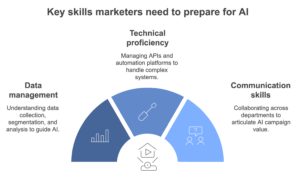From point solutions to fully autonomous pipelines
AI today operates like a reliable assistant, helping marketers handle specific tasks like writing content, analyzing performance data, or generating images. These tools are impressive but limited as they rely heavily on human intervention. Think of them like lane-assist technology in a car. Useful? Absolutely. Independent? Not even close.
What’s coming next is the “self-driving car” of marketing: fully autonomous pipelines. These systems are designed to take the wheel entirely, from the first brainstorming session to optimizing campaign performance. Imagine it like setting a destination—like increasing engagement by 20%—and the system handles everything else. It crafts the creative, deploys it across channels, tests different variations, and fine-tunes the campaign in real-time to hit your goals.
Why does this matter? Because efficiency skyrockets when human bottlenecks disappear. Marketers spend less time in the weeds tweaking ads or monitoring performance and more time steering the broader vision. This shift is inevitable as providers consolidate today’s fragmented solutions into unified platforms.
Companies like HubSpot and Adobe already integrate AI into broader suites, but the future takes it further—eliminating manual workflows altogether. For businesses, this means cutting costs, accelerating time-to-market, and amplifying the creative potential of human teams.
We’re shifting to unified, data-driven marketing workflows
We’re moving toward a world where marketing operates like a finely tuned engine. Autonomous pipelines will shift workflows from fragmented tasks to smooth processes driven entirely by data.
Here’s how it works: instead of launching a campaign, waiting weeks for feedback, and manually tweaking elements, these systems continuously optimize themselves. AI generates ad variations, tests them in real time, and reallocates budgets to the best-performing options. It refines targeting, adjusts messaging, and shifts between platforms without a human ever stepping in.
What does this mean for marketers? It’s less about execution and more about orchestration. Marketers collaborate with AI to define overarching strategies—who the audience is, what the message should convey, and the key outcomes to achieve. The heavy lifting, the grunt work? That’s AI’s niche now.
It’s the kind of system that both saves time and opens new possibilities. With these tools in play, marketers can run hyper-personalized campaigns at a scale that would have been impossible a decade ago. They can react instantly to data, making sure every dollar works harder.
New roles and responsibilities in an autonomous marketing world
The rise of autonomous pipelines isn’t focusing on replacing people, it’s more about elevating them. Marketers won’t be running campaigns, they’ll be guiding the machines that do.
Take writers and designers, for example. Instead of crafting every headline or layout themselves, they’ll define parameters—brand tone, visual guidelines, and creative direction—that AI tools use to produce content at scale. Think of it like teaching an apprentice: you’re shaping their output without doing all the work yourself.
New roles will emerge, too. Data governance will become a top priority as AI-driven pipelines require clean, structured inputs to function effectively. Specialists will troubleshoot and fine-tune systems, so that the outputs align with strategic goals. Don’t forget ethics either, as someone needs to oversee how automation impacts audiences, from privacy concerns to bias in algorithms.
The biggest shift will be in creativity. Human ingenuity still outpaces AI when it comes to bold, original ideas. Marketers will focus on big-picture thinking, conceptualizing campaigns that AI can’t dream up. It’s less about execution and more about ideation—a role only humans can master.
Critical skills for marketers to start building today
Succeeding in this new world requires a serious upgrade in skills. The marketers of tomorrow need to be data-savvy, technically fluent, and exceptional communicators.
Let’s start with data. AI is only as good as the information it receives. Marketers need to understand how data is collected, segmented, and analyzed. They’ll use these insights to guide AI, identifying trends and responding when automation veers off course.
On the technical side, it’s not enough to understand basic tools. Marketers will need to manage APIs, manage automation platforms, and troubleshoot complex systems. It’s the kind of skill set that blurs the lines between marketing and IT, but it’s key for managing AI pipelines effectively.
Then there’s communication. Autonomous marketing doesn’t happen in a vacuum. It requires buy-in from leadership, collaboration with legal and IT teams, and clear reporting on results. Marketers must articulate the value of AI-driven campaigns and improve alignment across departments.

3 skill areas marketers need to develop to prepare for the future of autonomous marketing
Steps to prepare for autonomous marketing pipelines
Start with training. Identify the gaps in your team’s skills, whether it’s data analytics, automation platforms, or programming basics. Then, close those gaps with targeted courses, certifications, and mentorship programs. Pair less technical marketers with skilled team members to encourage learning through collaboration.
Next, experiment with small-scale automation. Automate routine tasks like content scheduling or email workflows and map your processes to identify opportunities for deeper integration. Choose tools that fit well into your existing systems, as compatibility matters more than bells and whistles.
Collaboration is key. Build cross-department connections early by forming an AI council with representatives from IT, legal, and data teams. Focus here should be on building a shared understanding of how AI will shape your business.
Finally, think strategically. Automation, while it does save time, is more about aligning technology with long-term goals. Whether it’s improving customer experience or driving growth, the most successful teams will keep their eyes on the bigger picture.





